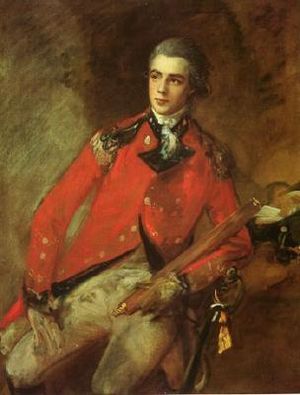William Cathcart, 1st Earl Cathcart facts for kids
Quick facts for kids
The Earl Cathcart
|
|
|---|---|

The 1st Earl Cathcart
|
|
| Nickname(s) | Cath |
| Born | 17 September 1755 Petersham, England, Kingdom of Great Britain |
| Died | 16 June 1843 (aged 87) Glasgow, Scotland, United Kingdom of Great Britain and Ireland |
| Allegiance | |
| Service/ |
|
| Rank | General |
| Commands held | Commander-in-Chief, Scotland Commander-in-Chief, Ireland |
| Battles/wars | American Revolutionary War |
| Awards | Knight of the Order of the Thistle Order of St. Andrew (Russia) Order of St. George of the Fourth Degree (Russia) |
William Schaw Cathcart, 1st Earl Cathcart (born September 17, 1755 – died June 16, 1843) was an important British soldier and a diplomat. He was known for his leadership in several wars and for representing his country in other nations.
Contents
Early Life and Education
William Cathcart was born in Petersham, England. His father was Charles Cathcart, 9th Lord Cathcart, who was also a general. William went to Eton College, a famous school.
In 1771, when he was 16, William went to St. Petersburg, Russia. His father was working there as an ambassador. William became a very good horse rider during his time in Russia. After returning, he studied law at the University of Glasgow from 1773 to 1777. He then became a lawyer in Scotland. When his father died in 1776, William inherited his father's title and properties.
Military Career Highlights
William Cathcart began his military career in 1777. He joined the 7th Dragoons, an army unit.
Fighting in America
Later in 1777, he went to America to fight in the American Revolutionary War. He quickly earned promotions because of his bravery. He joined the 17th Light Dragoons. In 1778, he showed great skill in scouting and leading small groups. He even commanded a special group called the British Legion very successfully at the Battle of Monmouth. He also helped manage supplies for the army. He returned home to Britain in 1780.
Cricket and Promotions
In 1781, he became a captain and lieutenant colonel in the Coldstream Guards. In 1784, William Cathcart organized the first official cricket match in Scotland. This event took place at his home, Schawpark.
He continued to rise in the army. In 1792, he became a colonel. He fought well in battles in the Low Countries (like Belgium and the Netherlands) between 1793 and 1795. During this time, he was promoted to major general. By 1801, he was a lieutenant general. He also received other important roles, like Vice Admiral of Scotland.
Leading Expeditions
From 1803 to 1805, Lord Cathcart was the Commander-in-Chief in Ireland. In 1805, he led a British army to Hanover, a German region. His mission was to take control of Hanover. He successfully occupied the area in December. However, he had to leave in 1806 after an agreement between France and Prussia.
After this, Cathcart commanded the forces in Scotland until 1807. That year, he led an important mission to Copenhagen, Denmark. His forces successfully captured Copenhagen on September 6. Because of this victory, he was given new titles: Viscount Cathcart and Baron Greenock. He then returned to his command in Scotland.
Ambassador to Russia
On January 1, 1812, William Cathcart became a full general. A few months later, he went to Russia. He served as both an ambassador and a military representative. He worked closely with the allied forces during the War of the Sixth Coalition (1812–1814). This war was also known as the War of Liberation. He was very good at keeping the generals from different countries working together. For his success, he was given the title of Earl in July 1814. He stayed in St. Petersburg as ambassador until 1820.
William Cathcart passed away at his home near Glasgow on June 16, 1843. He is buried in Paisley Abbey.
Family Life
William Cathcart married Elizabeth Elliot in 1779. She was the daughter of the lieutenant-governor of New York. They had ten children together. Their first child, Louisa, was born in New York in 1780 but sadly died soon after.
Two of their sons, Sir George Cathcart and Sir Charles Cathcart, also became generals in the army. Charles inherited his father's title when William died.
Another son, William Cathcart, joined the Royal Navy. Sadly, he died from yellow fever in 1804 while commanding his ship, HMS Clorinde.
When William Cathcart was ambassador to Russia, two of his sons went with him. Captain Frederick Macadam Cathcart was his private secretary. Lieutenant George Cathcart was his aide. His youngest son, Adolphus Frederick Cathcart, was born in 1803.
Images for kids
See also
- List of ships named Lord Cathcart


